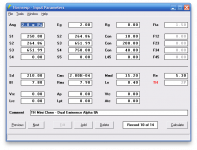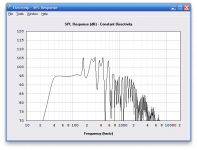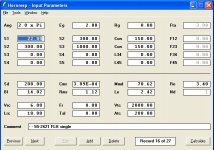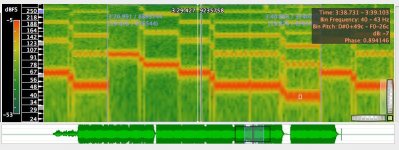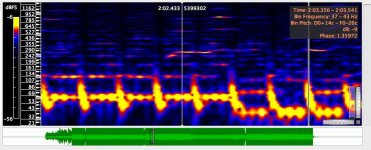Hi Folks,
A friend of mine wants to put together a sound system he can run off a 12v deep cycle battery.
Specifically, this is likely to get used in three ways:
- At burning man for music in his family's camp's bar
- Power free DJ rig for bonfire parties held on a friend's farmland
- A bike towed trailer for various bike related events here
Generally this constrains us to maximizing sensitivity. It'll likely be powered by a modest class D amp (tripath module or comparable). I'm using one cell and 10 watts delivered to the load as a design point. We may be able to bump this, but it's a good starting point for a current draw that would allow 6 to 8 hour operation with modest battery cost (ie, low enough to run in the evening/night for several hours without charge from a solar panel set). For obvious reasons we'll be targeting a 4ohm load.
As for size, the bike usage restricts us to something 0.5m^3 or so.
I think a tapped horn may be ideal for this situation, for several reasons:
- Generally have a sensitivity advantage over vented/sealed alignments
- Excursion is minimized, allowing us to use higher sensitivity low xmax PA drivers
- FS can be significantly above the target f3, again suitable for high sensitivity PA drivers
While I'd love to get extension to 30hz for some of the likely music played (dubstep, etc) I think a f3 in the 40-50hz area is more realistic.
Also, I'd like to keep cost modest. I've talked with more than a few people who'd like to copy the subwoofer design if it's in the neighborhood of $100. Sadly this limits us from some particularly attractive drivers like the B&C 12.
So far the design I'm happiest with is 2x Alpha 8A's in a 40hz tapped horn. Essentially a clone of the TH mini but adjusted a bit. This models with a ruler flat response and 95dB sensitivity. It'll likely be usable up to 200hz or more depending how bad the resonance harmonics measure in practice. Pics included below.
Anyhow, I'd like to know if this project sparks any ideas with folks, particularly for drivers or alternate alignments/approaches.
A friend of mine wants to put together a sound system he can run off a 12v deep cycle battery.
Specifically, this is likely to get used in three ways:
- At burning man for music in his family's camp's bar
- Power free DJ rig for bonfire parties held on a friend's farmland
- A bike towed trailer for various bike related events here
Generally this constrains us to maximizing sensitivity. It'll likely be powered by a modest class D amp (tripath module or comparable). I'm using one cell and 10 watts delivered to the load as a design point. We may be able to bump this, but it's a good starting point for a current draw that would allow 6 to 8 hour operation with modest battery cost (ie, low enough to run in the evening/night for several hours without charge from a solar panel set). For obvious reasons we'll be targeting a 4ohm load.
As for size, the bike usage restricts us to something 0.5m^3 or so.
I think a tapped horn may be ideal for this situation, for several reasons:
- Generally have a sensitivity advantage over vented/sealed alignments
- Excursion is minimized, allowing us to use higher sensitivity low xmax PA drivers
- FS can be significantly above the target f3, again suitable for high sensitivity PA drivers
While I'd love to get extension to 30hz for some of the likely music played (dubstep, etc) I think a f3 in the 40-50hz area is more realistic.
Also, I'd like to keep cost modest. I've talked with more than a few people who'd like to copy the subwoofer design if it's in the neighborhood of $100. Sadly this limits us from some particularly attractive drivers like the B&C 12.
So far the design I'm happiest with is 2x Alpha 8A's in a 40hz tapped horn. Essentially a clone of the TH mini but adjusted a bit. This models with a ruler flat response and 95dB sensitivity. It'll likely be usable up to 200hz or more depending how bad the resonance harmonics measure in practice. Pics included below.
Anyhow, I'd like to know if this project sparks any ideas with folks, particularly for drivers or alternate alignments/approaches.
Attachments
Speakerplans has some really cool stuff, and I've been digging through there, but:
- their "official" plans are all a little bigger than I'm looking for
- very little of the stuff in the 12v forum has any sort of design or measurement, mostly just combining bargain pa parts (a few are downright stunning though).
Also, my overall goals are slightly different than a lot of the systems there also. I want more of a compromise between fidelity and spl.
- their "official" plans are all a little bigger than I'm looking for
- very little of the stuff in the 12v forum has any sort of design or measurement, mostly just combining bargain pa parts (a few are downright stunning though).
Also, my overall goals are slightly different than a lot of the systems there also. I want more of a compromise between fidelity and spl.
I keep coming back to the $25-$30 mcm 55-2421 in a FLH. I set up a 12v redneck soccer field system for a friend using these. (actually it was running off of a pair of my dual driver 55-2421 cabinets) Dual battery on a diesel pickup runs all day. My tops end up eating more juice than the subs...
However, this is exactly the same size (120liter) as your TH, uses only a single, cheaper driver, and gives a couple more db output. Standard 80hz cross flattens the midbass spike, and you end up with flat from 40 to about 160-180.
If you have the travel room for a couple of them, you can set them up in a 'V' shape, put a piece of plywood over the top, and gain even a little more output. A pair of these running off of a T-amp, should get you 95db at 10m. While that is not earth shaking bass, it'll fill out the bottom end, and get you good sound, on very little power.
Take them indoor, and put them in a corner, and they really come to life.
my 2c.
However, this is exactly the same size (120liter) as your TH, uses only a single, cheaper driver, and gives a couple more db output. Standard 80hz cross flattens the midbass spike, and you end up with flat from 40 to about 160-180.
If you have the travel room for a couple of them, you can set them up in a 'V' shape, put a piece of plywood over the top, and gain even a little more output. A pair of these running off of a T-amp, should get you 95db at 10m. While that is not earth shaking bass, it'll fill out the bottom end, and get you good sound, on very little power.
Take them indoor, and put them in a corner, and they really come to life.
my 2c.
Attachments
Last edited:
As I understand it you're mostly going to use it outdoors. In that case I'd forget everything about getting subbass for 2 reasons; a) it'd require much higher power than a 12V system can provide without a dc-dc converter and b) it's completely irrelevant outdoors as subbass can't be heard outdoors anyways unless you provide 4 to 64 times the output (6 to 24 dB higher output, more and more at lower and lower frequencies) than you'd need indoors.
Besides there's not really any subbass in dubsteb, most of the bass output in dubsteb is above 100 Hz. Basically there's only distortion effects below that. On top of that because of some wierd psychoaucoustic effect that I can't explain the brain thinks there's subbass if you provide a 3-6 dB peak at 100-120 Hz and a steep drop-off below that.
I'd recommend the HD15 horn from www.speakerplans.com as it's perfectly suited for your use. It doesn't play subbass, and have the needed peak in the 100-120Hz area. At 102-105 dB average sensitivity over the usable range depending on driver, it's pretty unbeatable. If you can get them use a P.Audio WN-15S driver for these horns as they're relatively low cost, and extreme value for money. If used indoors, either apply a notch filter to flatten the response or use with a 21" scoop horn.
Besides there's not really any subbass in dubsteb, most of the bass output in dubsteb is above 100 Hz. Basically there's only distortion effects below that. On top of that because of some wierd psychoaucoustic effect that I can't explain the brain thinks there's subbass if you provide a 3-6 dB peak at 100-120 Hz and a steep drop-off below that.
I'd recommend the HD15 horn from www.speakerplans.com as it's perfectly suited for your use. It doesn't play subbass, and have the needed peak in the 100-120Hz area. At 102-105 dB average sensitivity over the usable range depending on driver, it's pretty unbeatable. If you can get them use a P.Audio WN-15S driver for these horns as they're relatively low cost, and extreme value for money. If used indoors, either apply a notch filter to flatten the response or use with a 21" scoop horn.
Last edited:
Anyhow, I'd like to know if this project sparks any ideas with folks, particularly for drivers or alternate alignments/approaches.
Your attached calculation assumes indoor use, so it's useless outdoors. Apply a 12 dB/octave filter starting at 120 Hz to that calculation and you're getting close to the real output the speaker will have outdoors.
jason
The guys over the pond have laid out how to do it all though.
Not saying you HAVE TO HAVE the EXACT same thing. Just use as a basis.
So first. Forgo PA speakers and Home Audio
and go for drivers that are in the car audio realm. These will have lower resistance. Hell I have seen 1 ohm DVC drivers. That means they can run at 1/2 ohm load. So the size of amp needed is smaller.
I also agree with Saturnus that going that
low isn't needed. I would cut of at 60-80 Hz with a sharp cut off.
Using deep cycle laptop batteries, radio shack solar panels to recharge, car audio amps, crossover and speakers. A good pair of 6x9's. Hell you could even horn load those if you need more direction at of them. And a small TH loaded with something that is 2 ohm or less.
The guys over the pond have laid out how to do it all though.
Not saying you HAVE TO HAVE the EXACT same thing. Just use as a basis.
So first. Forgo PA speakers and Home Audio
and go for drivers that are in the car audio realm. These will have lower resistance. Hell I have seen 1 ohm DVC drivers. That means they can run at 1/2 ohm load. So the size of amp needed is smaller.
I also agree with Saturnus that going that
low isn't needed. I would cut of at 60-80 Hz with a sharp cut off.
Using deep cycle laptop batteries, radio shack solar panels to recharge, car audio amps, crossover and speakers. A good pair of 6x9's. Hell you could even horn load those if you need more direction at of them. And a small TH loaded with something that is 2 ohm or less.
Forgo PA speakers and Home Audio
and go for drivers that are in the car audio realm. These will have lower resistance. Hell I have seen 1 ohm DVC drivers. That means they can run at 1/2 ohm load. So the size of amp needed is smaller.
You mean the needed amp is larger, right?
Unfortunately most car speakers have horribly low efficiency, so I'd definitely recommend pro speakers instead. For example the P.Audio WN15S as I recommended has a 100 dB/2.82V/m sensitivity and being 8 Ohms which means it'll play just as loud on 1 Watt as a 15" car sub with 97 dB/2.82V/m sensitivity and being 2 Ohms will on 4 Watts. That's not counting the natural loss in wires that lower VC resistance leads to as well.
I almost always advice people to stay far away for any kind of car audio equipment when not used in it's intended enviroment, ie a car, where you have an engine to provide you with all the power you need. Car audio equipment is practically never made with low power consumption in mind, quite the opposite actually as you can see a car audio blast off where people stuff their van with several several thousand watt amplifiers to drive their ridiculously low efficiency subs.
They're half space (ie groundplane). No room gain is assumed.Your attached calculation assumes indoor use, so it's useless outdoors. Apply a 12 dB/octave filter starting at 120 Hz to that calculation and you're getting close to the real output the speaker will have outdoors.
I've not heard of this second order fall off at 120hz due to being outdoors. Can you explain further or provide a reference?
PS. Your boombox project is neat. Not quite the same as I'm going for, but cool.
They're half space (ie groundplane). No room gain is assumed. I've not heard of this second order fall off at 120hz due to being outdoors. Can you explain further or provide a reference?
Actually the room gain is assumed in that calculation. The exact frequency varies a bit depending on room size the unit was supposed to work in but the outdoors drop-off on a speaker designed for indoors use is most often set to around 12 dB/octave starting at 100-120 Hz.
You should note that it's not actually drop-off in the sense that it is lower output but instead a drop-off because you're not able to hear it because of low frequency background noise. The result is the same though in that you need higher output to compensate.
Last edited:
There is no room gain in that calculation. Hornresp does not have a room gain feature AFAIK. It does assume halfspace radiation angle, which I believe is a reasonable assumption.Actually the room gain is assumed in that calculation.
This discussion got me curious, so I looked at some tracks in a spectrograph. Now, these are mp3's, so the bass region will have been crushed, but for our purposes, that makes them a conservative representation: if anything the raw audio will have more energy in this region.
Top image is one of Skream's remix of La Roux's In for the Kill. The fundamentals are all 100-40hz, with the lowest right on 40hz. There are a lot of harmonics, but the next harmonic is about -6dB and they drop faster after that. I'd guess this is why the emphasis around 100hz in your system works so well, it brings up the first harmonic of the bassline to the amplitude the fundamental would be if it were present.
Second image is a remix of Coeur de Pirate's Comme des Enfants, a much more poppy track. Again we see lowest fundamentals at around 40hz, and that the bulk of the kick's energy is in the 40-80 region.
So, while writing off below 80hz might be a good compromise depending how loud you want to go, I don't think it's true to say there isn't much content there in dubstep (or in dance music in general).
Attachments
So, while writing off below 80hz might be a good compromise depending how loud you want to go, I don't think it's true to say there isn't much content there in dubstep (or in dance music in general).
I make electronica music with some of my friends on occasitions, some for sale at iTunes some free at http://www.retrofox.dk/, so I know what I'm talking about. After listening to it for a few minutes you will not notice the deepbass missing provided you have the 3-6 dB peak in the 100-120 Hz range ... outdoors that is.
As any sound engineer will know sound behaves quite differently outdoors but you can either take my word for it, or test it yourself.
Last edited:
- Status
- This old topic is closed. If you want to reopen this topic, contact a moderator using the "Report Post" button.
- Home
- Loudspeakers
- Subwoofers
- High Sensitivity Subwoofer for 12v battery based system
